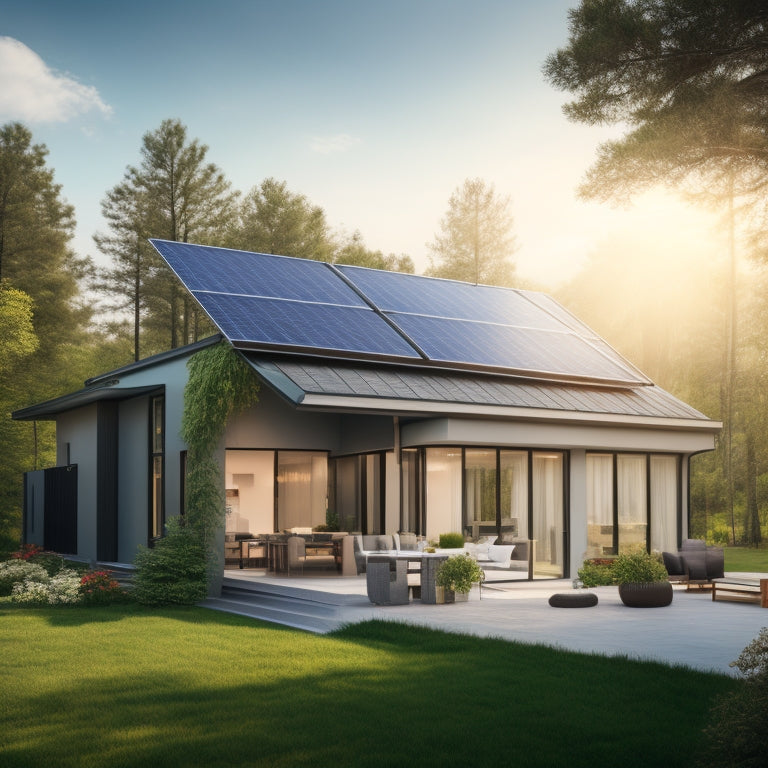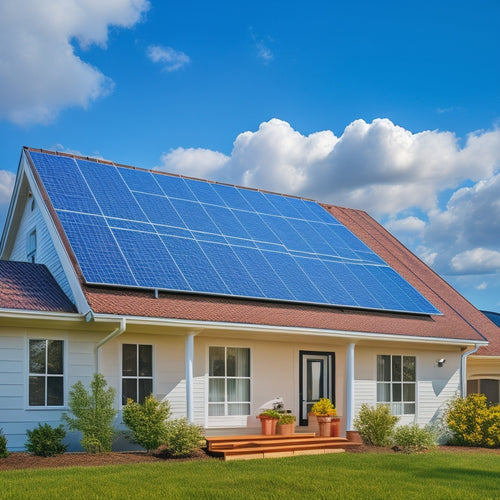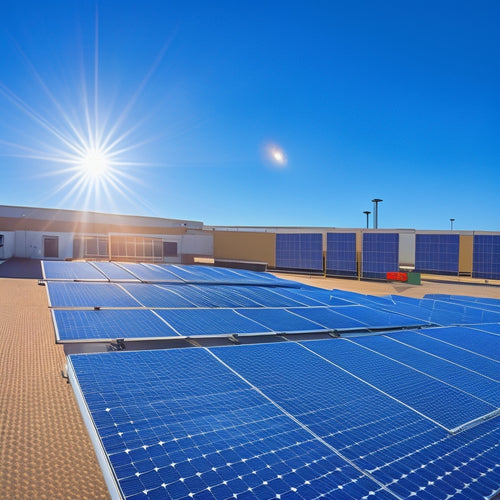
Seamlessly Integrating Solar Power Into Your Electrical System
Share
To seamlessly integrate solar power into your electrical system, start by evaluating your energy consumption patterns. Identify peak usage times for ideal solar utilization. Choose high-efficiency inverters and adequate battery storage to improve system performance. Aim for technology that minimizes energy loss during conversion and maximize energy independence by reducing reliance on the grid. Utilize government incentives to offset initial installation costs and consider quality components customized to your needs. This approach not only enhances financial savings but also supports environmental sustainability. Investigate further to uncover more about maximizing your solar integration effectively.
At a Glance
- Assess your energy consumption patterns to determine the optimal size and setup for your solar power system.
- Choose efficient inverters, such as microinverters or string inverters, to maximize energy conversion and minimize losses.
- Consider battery storage options to enhance energy management and provide backup during peak usage times or outages.
- Install smart meters for real-time monitoring of solar energy production and consumption to optimize usage.
- Utilize government incentives and rebates to reduce upfront costs and improve the financial viability of your solar integration.
Cost-Effective Energy Solution
Investing in solar power can lead to significant long-term savings on your energy bills, as you generate your own electricity.
Additionally, you may benefit from various government incentives and rebates that can offset initial installation costs.
By reducing utility costs by 50% to 100%, you can enhance your overall financial position and enjoy greater energy independence through considerable energy savings.
Long-Term Savings Potential
Utilizing solar power can lead to significant long-term savings on your energy bills, making it a cost-effective energy solution for homeowners and businesses alike. By conducting a thorough investment analysis, you can evaluate the upfront costs versus the projected savings over time.
Solar panels typically have a lifespan of 25 years or more, offering a stable return on your investment when you consider the rising costs of conventional energy sources.
Incorporating solar power into your electrical system allows you to lock in energy costs, shielding you from market volatility. With careful financial forecasting, you can estimate your potential savings based on your energy consumption patterns and local solar incentives.
This foresight not only aids in budgeting but can also enhance your energy independence, giving you more control over your utility expenses.
Furthermore, as technology advances, the efficiency of solar panels continues to improve, maximizing your savings potential. By embracing solar energy now, you're not just investing in a sustainable future; you're also ensuring that your financial freedom remains intact for years to come.
This long-term strategy changes solar power into a wise and liberating choice.
Government Incentives and Rebates
How can government incentives and rebates make solar power even more cost-effective for you? By leveraging federal grants and tax credits, you can greatly reduce your initial investment in renewable energy systems. These financial benefits are designed to encourage homeowners like you to adopt solar energy, enhancing your energy independence and reducing long-term costs.
Many state programs offer additional support, providing financing options that can ease the burden of upfront installation costs. This might include low-interest loans or direct installation assistance, ensuring that going solar is accessible for everyone.
Some states also provide green certifications for solar installations, which can further increase your property value and appeal to eco-conscious buyers.
To maximize your savings, consider scheduling energy audits that can identify areas for efficiency improvements. By integrating solar power into a well-optimized electrical system, you'll not only reduce your reliance on fossil fuels but also enhance your financial freedom.
The combination of government incentives and strong financing options enables you to take charge of your energy future, clearing the path for a sustainable lifestyle that benefits both you and the environment.
Environmental Impact Reduction
By integrating solar power into your electrical system, you greatly lower your carbon emissions, contributing to a cleaner environment.
This shift not only reduces reliance on fossil fuels but also promotes sustainable energy adoption, as solar energy reduces air pollution and greenhouse gas emissions.
Embracing solar technology positions you at the forefront of innovative energy solutions that benefit both your household and the planet, ultimately supporting climate change mitigation efforts through increased use of renewable energy sources.
Lower Carbon Emissions
As you integrate solar power into your electrical system, you'll notably lower carbon emissions and contribute to environmental impact reduction. By utilizing renewable energy, you directly decrease your carbon footprint, moving away from fossil fuels that greatly contribute to greenhouse gas emissions.
This shift not only supports personal freedom in energy choice but also aligns with a global movement towards sustainability.
Solar energy systems work by converting sunlight into electricity without emitting harmful pollutants. With each kilowatt-hour of solar power you generate, you replace conventional energy sources, thereby reducing reliance on carbon-intensive options.
This proactive approach allows you to play an active role in combating climate change, nurturing a cleaner environment for future generations.
Moreover, integrating solar power can enhance your energy independence. By generating your own electricity, you're less vulnerable to fluctuating fossil fuel prices and supply disruptions, allowing you to take control of your energy future.
As you adopt solar energy, you're not just cutting emissions; you're also creating a more sustainable and liberated lifestyle. It's a strategic investment that benefits both you and the planet, ensuring a greener tomorrow.
Sustainable Energy Adoption
Integrating sustainable energy sources into your electrical system isn't just a trend; it's an essential step toward minimizing environmental impact. By adopting renewable policies and accepting solar trends, you actively contribute to grid modernization, which enhances efficiency and resilience.
Community solar projects make it easier for you to participate in renewable energy, regardless of your property type or financial situation, promoting energy equity across diverse populations.
Boosting your energy literacy is crucial in steering this shift. Understanding sustainable practices equips you to make informed decisions that align with your values. As public awareness of climate issues grows, more individuals are recognizing the urgency of integrating solar power into their lives.
This collective movement not only reduces reliance on fossil fuels but also drives innovation in energy technologies.
Additionally, as you integrate these systems, you're participating in a broader change toward a sustainable future. By prioritizing sustainable energy adoption, you help create a cleaner environment for future generations.
Seize this opportunity to not just consume energy but to generate it responsibly, nurturing a culture of sustainability that enables you and your community. Together, we can build a greener, more equitable energy environment.
Key Technical Specifications
When integrating solar power into your electrical system, understanding inverter efficiency ratings and battery storage capacity is essential.
Selecting a quality solar battery system can greatly enhance your setup's effectiveness, as it allows for key considerations for selecting the right components customized to your energy needs.
These specifications directly impact your system's performance and reliability, ensuring you maximize energy production and storage.
Inverter Efficiency Ratings
Inverter efficiency ratings serve as an important measure of how effectively an inverter converts solar energy into usable electricity for your home. Understanding these ratings helps you select the right inverter type that meets efficiency standards, maximizing your solar investment.
Here's a brief overview of common inverter types and their efficiency ratings:
| Inverter Type | Efficiency Rating (%) |
|---|---|
| String Inverter | 95-98% |
| Microinverter | 95-97% |
| Power Optimizer | 96-99% |
| Central Inverter | 94-96% |
Choosing an inverter with a high efficiency rating is vital for optimizing your system's performance. Higher efficiency means less energy loss during the conversion process, translating to greater energy savings. For instance, a microinverter can offer better performance in shaded environments, while string inverters are often more cost-effective for larger installations.
When you're evaluating inverter options, always check their efficiency ratings and verify they meet the efficiency standards set by industry organizations. By doing so, you equip yourself to utilize solar energy with the precision and effectiveness that aligns with your freedom to generate clean energy.
Battery Storage Capacity
Battery storage capacity is an important specification that determines how much energy your solar system can store for later use. It's typically measured in kilowatt-hours (kWh), and the right capacity allows you to enjoy energy independence, especially during peak demand periods or outages.
When considering battery types, lithium-ion batteries are popular due to their high energy density and efficiency. They offer longer lifespans and faster charging times compared to traditional lead-acid batteries, making them ideal for residential solar setups. However, they tend to come with a higher initial cost.
Installation considerations play a significant role in optimizing your battery storage. You'll need to assess your energy consumption patterns and determine how much storage capacity meets your needs.
Make sure to factor in the available space and the environmental conditions, as these can impact battery performance and longevity.
Ultimately, the right battery storage capacity enables you to utilize solar energy freely, providing you with the resilience and flexibility to manage your energy needs effectively.
Assessing Your Energy Consumption
To effectively integrate solar power, start by analyzing your monthly utility bills to understand your overall energy consumption.
This awareness of cost components can help you make informed decisions about your energy storage solutions while pinpointing your peak usage times will also help you optimize solar energy production and consumption.
Analyzing Monthly Utility Bills
When reviewing your monthly utility bills, you can uncover useful observations into your energy consumption patterns. Start by performing a bill comparison over several months. This helps you identify any fluctuations in your energy costs and correlate those changes with specific events or habits.
By examining these variations, you can spot usage trends that may indicate inefficient energy practices. Look for any spikes in your bills that don't align with seasonal changes. This could point to devices drawing power unnecessarily or perhaps an increase in usage from energy-intensive appliances.
Understanding these patterns gives you the power to make informed decisions about your consumption habits. Additionally, categorize your energy usage into peak and off-peak times. This helps you strategize when to use high-demand appliances, optimizing your energy consumption.
If you can align your usage with lower rates, you'll save money while maintaining comfort in your home. Armed with this data, you're equipped to take control of your energy footprint.
Identifying Peak Usage Times
Identifying peak usage times is essential for optimizing your energy consumption and maximizing the benefits of solar power. By conducting a thorough peak demand analysis, you can pinpoint when your household's energy consumption is at its highest. This understanding allows you to align your solar energy production with your usage, ensuring that you utilize as much solar power as possible during these critical periods.
Start by reviewing your historical energy usage data. Look for patterns in your electricity consumption, focusing on daily and seasonal fluctuations. Usage pattern identification will reveal trends, such as increased demand during mornings or evenings. With this information, you can strategize when to run energy-intensive appliances or adjust your habits to coincide with your solar generation.
Consider utilizing smart meters and energy management systems to monitor real-time usage. These tools provide instantaneous feedback, enabling you to make informed decisions about your energy consumption.
Higher Energy Independence Potential
Integrating solar power into your electrical system greatly reduces your reliance on the grid.
By utilizing the sun's energy, you can generate electricity on-site, minimizing the need for external sources.
This shift not only enhances your energy independence but also stabilizes your energy costs against fluctuating market prices.
Reduced Reliance on Grid
Energy independence is a compelling advantage of incorporating solar power into your electrical system. By utilizing the sun's energy, you can greatly reduce your reliance on the grid, which translates into improved energy autonomy. This reduction in grid dependence not only shields you from fluctuating energy prices but also protects you from unforeseen outages, providing a sense of security for your home or business.
Implementing solar power benefits you in various ways. With a well-designed solar array, you can generate electricity that fits your consumption needs, allowing you to power your daily activities sustainably. This self-sufficiency enables you to take control of your energy future, reducing vulnerability to external energy sources.
Moreover, as your system becomes more efficient, you'll find that excess energy can be stored or even fed back into the grid, creating additional savings or revenue. The innovative technologies available today, such as smart inverters and battery storage solutions, enhance this potential for independence.
Ultimately, moving towards solar energy frees you from traditional energy constraints, allowing you to adopt a more resilient and sustainable lifestyle. Embrace the freedom solar power offers, and take charge of your energy destiny.
Frequently Asked Questions
How Long Does It Take to Install a Solar Power System?
The installation timeline for a solar power system typically ranges from a few days to a couple of weeks, depending on system components and local regulations. You'll appreciate the efficiency and freedom it offers.
What Maintenance Is Required for Solar Power Systems?
Maintaining solar power systems is essential for peak performance. You'll need regular system cleaning and inverter checks. With just a bit of effort, you can utilize solar energy like it's the sun's greatest gift to humanity!
Can Solar Power Work During Cloudy Days?
Yes, solar power can work during cloudy days, though solar efficiency decreases with cloud coverage. Your system still generates energy, capturing diffuse sunlight. Embracing this technology grants you greater energy independence, even in less-than-ideal conditions.
How Does Solar Energy Affect Home Resale Value?
Solar energy enhances your home's resale worth by showcasing energy efficiency and a strong solar investment. Potential buyers often seek properties with lower energy costs, making your solar system a significant asset in the real estate market.
What Incentives Are Available for Solar Power Installation?
Think of solar incentives as a financial sunbeam lighting your path. You can benefit from federal tax credits and state rebates, reducing installation costs and enhancing your freedom to utilize clean energy for your home.
Explore More
Incorporating solar power into your electrical system isn't just a bright idea; it's a wise investment in a sustainable future. By embracing this clean energy source, you're not merely reducing your carbon footprint, but also enhancing your energy independence. As you assess your energy consumption, remember that every little bit counts. Shifting to solar is like opening a door to a world of savings and environmental stewardship, ensuring your energy needs are met with innovation and responsibility.
Related Posts
-

Cost of Solar Panel Installation
You can expect to pay between $15,000 and $30,000 or more for a typical solar panel installation, depending on the sy...
-

Home Solar Installation Cost
You're considering installing solar panels on your home, and the upfront cost is likely the biggest hurdle standing i...
-

Essential Solar Panel Mounts for Commercial Properties
When it comes to essential solar panel mounts for your commercial property, durability and wind resistance are key fa...


